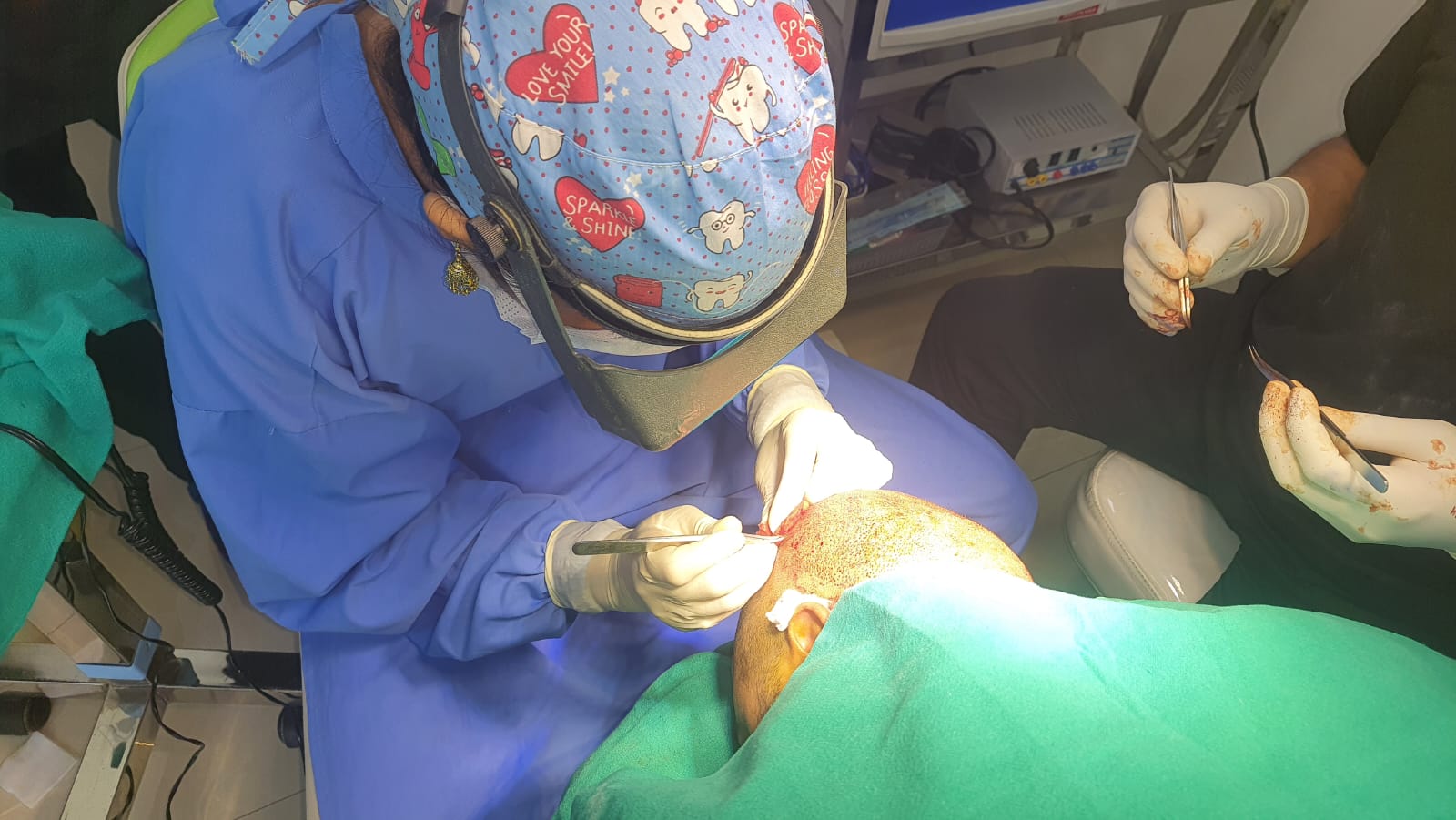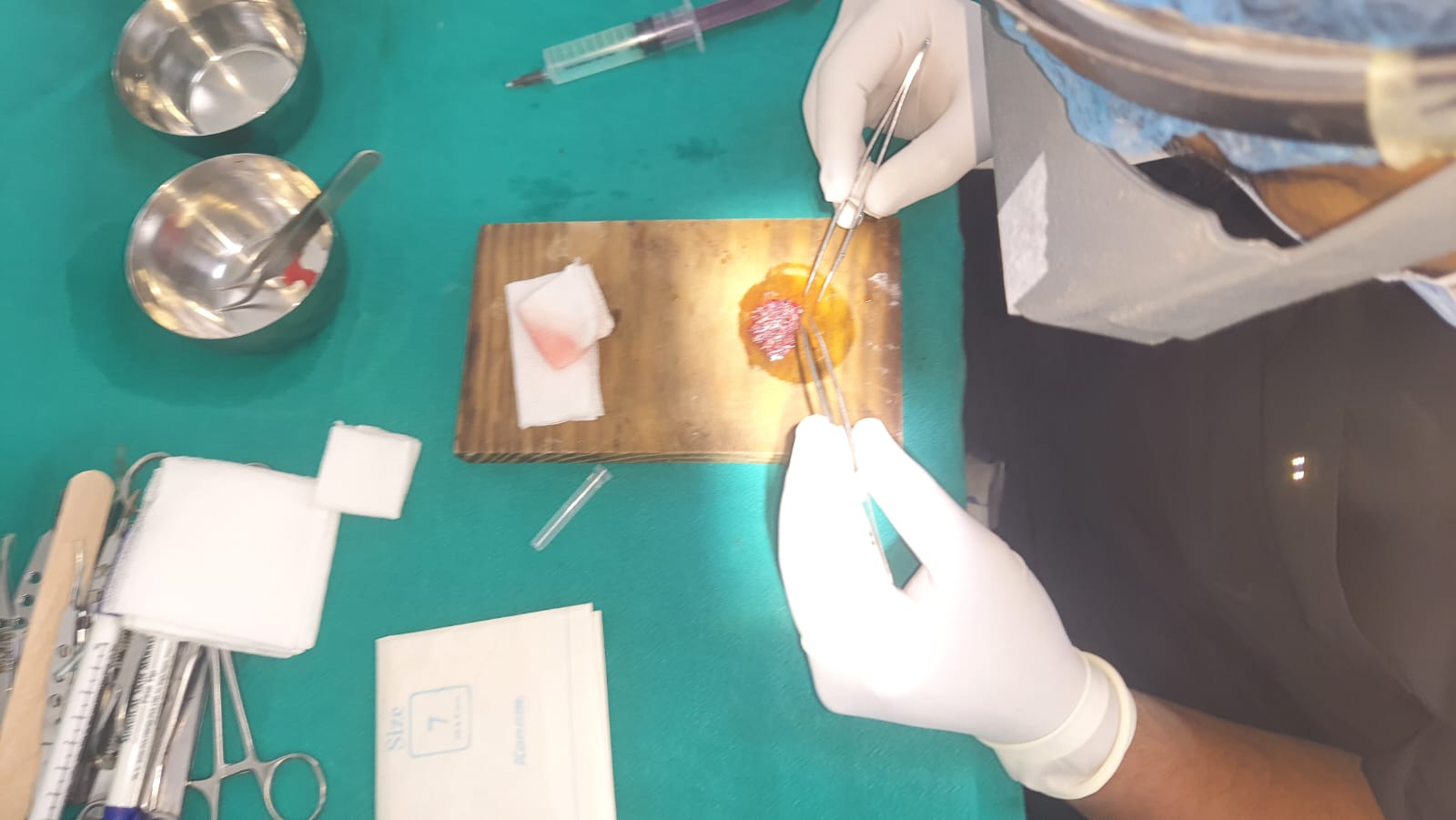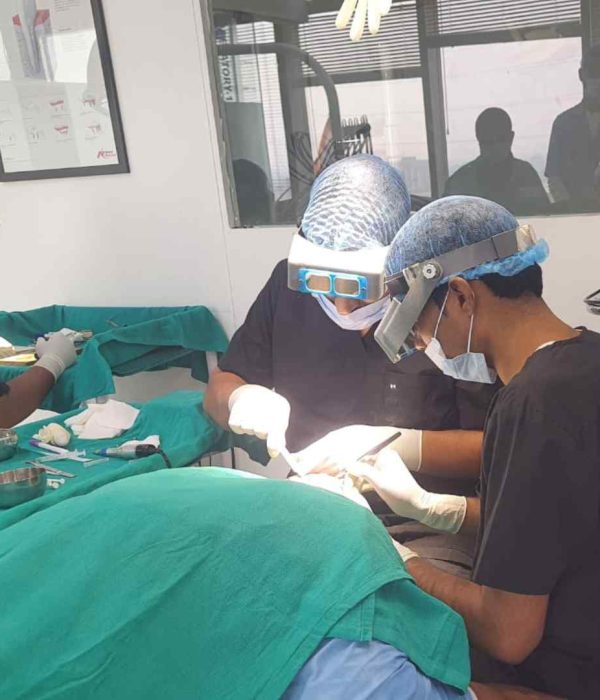HAIR TRANSPLANTATION Services
Our Excellent Hair Care Beauty Treatment Services...

PRP (Platelet-rich plasma therapy)
Effective in treating male pattern baldness, both in preventing hair loss and promoting new hair growth.

GFC (Growth Factor Concentrate Therapy)
An effective treatment to reduce hair fall and rejuvenate hair follicles

Mesotherapy
multiple intradermal or subcutaneous injections of a mixture of compounds in a minute dose...

Our Aesthetics Treatment Have Benefits For Your Skin & Beauty Care

What causes alopecia?
What is male pattern baldness?
Male pattern baldness, also known as androgenic alopecia, is an inherited trait. Medline Plus states that it affects more than half of men over the age of 50. However, stress or other autoimmune conditions, such as alopecia areata, can also affect hair loss. It’s typical to lose around 50 to 100 hairs every day. Usually, this loss isn’t noticeable because new hair grows to replace the lost hair. Hair loss and baldness occur when hair falls out too quickly or new hairs stop growing. Depending on the cause of hair loss, you may notice slowly thinning hair or a sudden bald patch. Hair loss can impact just the hair on your scalp or the entire body.
ALOPECIA AREATA
“Alopecia areata is a type of hair loss that is caused by a malfunctioning immune system that leads to attacking the follicles on the scalp and other areas of the body and disrupts the hair growth cycle,” a certified trichologist and founder of Zulfein explained.
This type of hair loss can be isolated to small spots, usually circles on the scalp or facial hair, but can extend to spreading to the entire head and then to the remainder of the body, Dr (Maj) C. Prakash added. Experts explain that enzymes can signal immune cells to generate proteins called cytokines and other chemical messengers called growth factors.
“When cytokines and growth factors are produced in abundance, they can cause chronic inflammation in autoimmune diseases such as alopecia areata.”
Causes of hair loss in males
Hair loss could be caused by:
- Genetics and family history: If your parents have hair loss, you’re more likely to develop it. Male pattern baldness or androgenic alopecia is a genetic condition where people gradually lose hair. This could show up as a slowing receding hairline or thinning patches on the crown of your head.
- Medication conditions: Some medical conditions, like hormonal problems or autoimmune diseases, cause hair loss. For example, thyroid problems, scalp infections, or trichotillomania (a hair-pulling disorder) could lead to thinning hair or bald patches. An autoimmune condition called alopecia areata develops when the immune system attacks hair follicles, resulting in bald patches.
- Stress: Chronic stress or stressful events could lead to temporary hair thinning.
- Medications and medical treatments: Hair loss is a potential side effect of several medications for conditions like cancer, depression, gout, heart disease, and arthritis.
No matter the cause, finding a treatment can vary based on the factors listed above and personal preference. To weigh your options, see which type of treatment could work best for you from our picks below.
Medication options
Prescription and over-the-counter (OTC) medication
The Food and Drug Administration (FDA) has approved two medications to treat male pattern baldness:
- Minoxidil (Rogaine): Rogaine is available over the counter as a liquid or foam in a men's and women’s Rogaine formula. It’s applied to the scalp twice per day to help encourage hair growth and prevent hair loss. Minoxidil is the active ingredient in Rogaine, and it’s also available in a generic form as a liquid solution or as an oral tablet. Both rogaine and minoxidil can take 4–6 months to see results. Results also depend on proper application and dosage.
- Finasteride (Propecia, Proscar): Finasteride is a pill that you take daily. It’s only available with a prescription from your doctor. The FDA states that it will generally take at least 3 months of daily use to see results from the drug
- Combination of minoxidil and finasteride: Some people experiencing hair loss may benefit from combining minoxidil and finasteride through a prescription treatment. While minoxidil is available over the counter, the highest available concentration is 5%. A prescription is required for anything above 5%, but through services like Roman, Keeps, and Happy Head, subscribers can be evaluated to see if they would benefit from this treatment and a minoxidil concentration above 5%.
For both minoxidil and finasteride, it may take up to 1 year to see results, and you’ll need to keep taking them to maintain the benefits.
What is Hair Transplantion?

A hair transplant is a procedure in which a plastic or dermatological head area surgeon usually moves hair from the back or side of the head to a bald area of the head. the front or top of the head.
Hair transplants typically occur in a medical office under local anesthesia.
Pattern baldness is responsible for the majority of hair loss. This comes down to genetics. The remaining cases are due to various factors, including:
- Diet
- Stress
- Illness
- Hormonal imbalance
- Medications
Are there different types of hair transplants?
There are two types of transplant procedures:
Slit grafts and
Micrografts
Slit grafts contain 4 to 10 hairs per graft. Micrografts contain 1 to 2 hairs per graft, depending on the coverage needed.
The two most popular hair transplant procedures are follicular unit transplantation and follicular unit extraction.
Keep in mind that both hair transplant procedures are considered surgery, so they can be expensive and may cause some level of discomfort.
There are also certain risks, including infections and scarring. You may need to do multiple hair transplant treatments to get the desired outcome.
Follicular unit transplantation (FUT)
In FUE, a surgeon removes hair follicles directly from the scalp and transplants them into the bald parts of the scalp. Direct hair implantation (DHI) is a modified version of this technique in which a specialized tool is used to complete the procedure.
Follicular unit extraction (FUE)
In FUE, a surgeon removes hair follicles directly from the scalp and transplants them into the bald parts of the scalp. Direct hair implantation (DHI) is a modified version of this technique in which a specialized tool is used to complete the procedure.
What happens during a hair transplant?
After thoroughly cleaning your scalp, a surgeon uses a small needle to numb an area of your head with local anesthesia.
Two main techniques are used to obtain follicles for transplantation: FUT and FUE.
In follicular unit transplantation (FUT):
- The surgeon will use a scalpel to cut out a strip of scalp skin from the back of the head. The incision is typically several inches long.
- This is then closed with stitches.
- The surgeon next separates the removed portion of the scalp into small sections using a magnifying lens and a sharp surgical knife. When implanted, these sections will help achieve natural-looking hair growth.
In follicular unit extraction (FUE), the hair follicles are cut out directly from the back of the head through hundreds to thousands of tiny punch incisions.
- The surgeon makes tiny holes with a blade or needle in the area of your scalp that’s receiving the hair transplant. They gently place hairs in these holes.
- During one treatment session, a surgeon may transplant hundreds or even thousands of hairs.
- After, the graft, gauze, or bandages will cover your scalp for a few days.
Laser treatment
Lasers are thought to help reduce the inflammation in follicles that prevents regrowth for some types of hair loss like alopecia areata. Dr (Maj) C prakash suggests that treatment from low-level laser therapy (LLLT) may increase hair growth although there are limited studies to support the effectiveness of laser treatments for hair loss. LLLT is safe and effective method when used to treat male pattern hair loss.
Who might benefit from a hair transplant?
Receiving a hair transplant can improve your appearance and self-confidence. Good candidates for a hair transplant include:
- Men with male pattern baldness
- Women with thinning hair
- Anyone who has lost some hair from a burn or scalp injury
Hair replacement isn’t a good option for:
- Women with a widespread patterb of hair loss throughout the scalp
- People who don’t have enough “donor” hair sites from which to remove hair for transplant
- People who don’t have enough “donor” hair sites from which to remove hair for transplant
- People whose hair loss is due to medication such as chemotherapy
Can you actually stop hair loss? Can hair grow back after balding?
It is possible to regrow hair with treatment, medication, or a combination of the two, but there are still some instances and conditions where regrowth is not possible.
If you’re experiencing hair loss or thinning tied to a period of increased stress or a change in your nutrition, you will likely begin to regrow hair over time when your stress levels drop or you make changes to your nutritional intake.
However, if your hair loss is caused by a condition like alopecia areata or alopecia totalis or by scalp damage and scarring, it is unlikely that typical medications like minoxidil and finasteride will stimulate hair growth.
If you find limited results from home remedies or OTC products like Rogaine, talk with a healthcare professional about what might be causing your hair loss and how best to treat it.
What are the complications associated with a hair transplant?
Side effects from a hair transplant are usually minor and clear up within a few weeks. They can include:
- Bleeding
- Infection
- Swelling of the scalp
- Bruising around the eyes
- A crust that forms on the areas of the scalp where hair was removed or implanted
- Numbness or lack of sensation in the treated areas of the scalp
- Itching
- Inflammation or infection of the hair follicles, which is known as folliculitis
- Shock loss, or sudden but typically temporary loss of the transplanted hair
- Unnatural-looking tufts of hair
What is the long-term outlook?
Typically, people who’ve had a hair transplant will continue to grow hair in the transplanted areas of the scalp.
The new hair may appear more or less dense depending on:
- scalp laxity, or how loose your scalp skin is
- Density of follicles in the transplanted zone
- Hair caliber or quality
- Hair curl
If you don’t take medication (such as minoxidil or finasteride) or undergo a low level of laser therapy, you may continue to experience hair loss in nontreated areas of your scalp.
Discussing the expected outcome with your surgeon and developing realistic expectations is important.
Lifestyle changes
Quit smoking
It has been found that the majority of those who smoked had some degree of hair loss, compared with less than half of the participants who did not smoke.
If you smoke, quitting may help decrease hair loss.
Scalp massage
Not only do massages feel wonderful, but they may help with hair loss, too. Massaging the scalp stimulates the hair follicles.
Balanced diet
A Balance deit may help keep your hair healthy. It’s important to include a variety of vegetables, fruits, whole grains, unsaturated fats, and lean proteins in your diet. Limiting sweets is also helpful.
- Iron-rich foods, including lean beef, beans, green leafy vegetables, iron-fortified grains, and eggs
- Food rich in omega-3 fatty acids such as salmon, mackerel, tuna, flaxseeds, egg yolks, hemp seeds, and walnuts
- High protein foods such as eggs, lean meats, and seafood
- Drinking plenty of water is also an important part of a balanced diet.
Reduce stress
Stress can have adverse effects on the body, including your hair, and can lead to hair loss.
Strategies to help reduce stress include:
- Regular physical activity like exercising listening to music
- Practicing yoga
- Meditation
- Getting enough sleep
Natural remedies
- Oils
- Biotin
Biotin is a vitamin found naturally in foods like:
- nuts
- sweet potatoes
- eggs
- onions
- oats
- Bhringraj
Bhringraj (Eclipta alba), also called false daisy, is a species in the sunflower family. In Ayurvedic medicine, it’s known as an herb that supports hair growth.
- Green tea
Another purported herbal remedy for hair loss is green tea.
- Hibiscus
- Hibiscus


Hair care tips
Be gentle with your locks
Try to be as gentle as possible when brushing or styling your hair. Constantly twisting, twirling, or pulling your hair tight can lead to hair loss.
If you’re worried about hair loss, you may want to avoid the following:
- Tight hairstyles, such as pigtails, cornrows, braids, and buns
- Chemicals used in perms and hair straightening treatments
- Hot curling irons or straightening irons
If you do use chemicals or bleach in your hair, get help from a trained professional. Do not try to do it yourself at home.
Get a checkup
Aside from your genetics, several medical conditions can cause hair loss. Treating any underlying medical conditions can help address your hair loss.
The following conditions could lead to hair loss:
- Diabetes
- lupus
- Lichen planus
- Sarcoidosis
- Scalp psoriasis
- Alopecia areata
- Thyroid conditions
- Eating disorder, due to poor nutrition
- Iron deficiency anemia
- Hair-pulling disorder, known as trichotillomania
- Celiac disease
- Syphilis
Frequently asked questions about hair transplants
Is a hair transplant painful?
The good news is, no—a hair transplant is not painful. At the time of the procedure, the area of your scalp that the surgeon will be focusing on will be numbed with a local anesthetic, so while you may feel a little pressure or movement sensations during the procedure, it shouldn’t be painful.
But like with most post-surgery recovery, you may experience discomfort or pain at the incision points as your body starts to heal and recover. Your medical team will likely discuss the best ways to manage pain and other ways to minimize the risk of negative side effects or reactions.
Is it worth getting a hair transplant?
A hair transplant is a good option for people who can afford the high cost of the procedure and haven’t found success with treatments like minoxidil and other topical and oral substitutes for avoiding transplants. Hair transplant surgery is relatively low-risk compared with other surgeries, but it isn’t without risks. There is also always the possibility that your hair regrowth may be minimal.
But if this is a procedure you are interested in and the potential rewards outweigh the costs and risks, consider talking with your doctor to see if this is a good option.
Takeaway
If you are experiencing hair loss or hair thinning, there are treatment options available. But no single treatment is guaranteed to work, and the costs can stack up quickly, especially since hair loss treatments are rarely covered by insurance.
But if you’ve talked with your doctor about treatments or found that other common hair regrowth treatments hadn’t worked for you, consider looking into a hair transplant. If you are a good candidate for the transplant and your medical team thinks you’re likely to see positive results, this may be a procedure worth considering.
How much does hair loss treatment cost?
The cost of hair loss treatment depends on which treatment you decide to try.
For example:
- Brand name or generic prices for Minoxidil can cost around rs 500-2000 for a 3-month supply.
- Hair transplants can cost anywhere from Rs 60000 to Rs 150000 depending upon the grafts required.
What you need to know about Hair Transplant in gurugram, Haryana?
Hair Transplant, also known as hair restoration surgery, is the surgical process of moving hair follicles from one part of the body that is rich in hair (known as a donor site) and embedding them at the bald area of the head (recipient site). The medical course of action aims at addressing hair loss issues and improving aesthetics. While there are many causes of hair loss, the most common reason, especially for men, is genetics. Hereditary hair loss as men age is the number one leading factor of baldness.
It is a minimally invasive procedure, performed under local anesthetic and is most commonly used to treat male baldness, but the technique can also be used to restore eyelashes, eyebrows, beard hair and to fill in scars. The procedure usually lasts between 4 to 8 hours, depending on the number of grafts needed. This procedure is a long-term solution to hair loss, with most patients experiencing significant improvement in hair growth after six months to a year.
What's the Recovery Time for Hair Transplant Procedures in our centre?
Your scalp will continue to be sensitive to pain for a few days, during which time you should continue to take the medications provided by the doctor. On top of the painkillers and anti-inflammatory medications, you may also be given antibiotics to lessen the risk of infection, as uncommon as this may be.
You should expect to return to work and your daily routine, including exercise, after 5 days. However, the signs of a hair transplant will remain for at least another 2-3 weeks, at which point the newly transplanted hairs will start to fall out, but don’t be alarmed! This is to be expected as you’ve just had a follicle extraction, so dead hair will simply make way for new hair over the coming weeks and months.
If the average person’s hair only grows by a centimeter per month, then it will take some time before you can wear your hair long again. You could expect to display short and consistent hair just 4-6 weeks after the treatment.
What's the Success Rate of Hair Transplant Procedures in Gurgaon?
The success rate for hair transplants is one of the highest, at 98%, and it is considered the only truly effective remedy for hair loss.
The effectiveness of hair transplant treatments is significantly shaped by the surgeon’s expertise in executing the process. A seasoned and competent surgeon employs sophisticated methods to prevent harm to the transplanted hair follicles during the process, which leads to a higher likelihood of success. Additionally, the ability of the surgeon to place the grafts in an attractive manner that resembles natural hair growth further enhances the perceived success of the result.
Beyond the competency of the surgeon, the overall health status and lifestyle choices of the patient greatly impact the treatment’s effectiveness. Subpar habits such as excessive smoking and alcohol intake can obstruct the recovery process and influence the result adversely. Illnesses like diabetes can also interfere with the likelihood of success.
Consideration of the donor hair’s quality is another aspect that may affect the success of the procedure. Generally, those with robust, plentiful hair in the donor region have a higher success rate as compared to individuals with sparse or poor-quality hair. The availability of more follicles for transplantation yields better results. A detailed examination is carried out before the hair transplant to verify the quantity and quality of the donor’s hair.
Lets Get Appointment Of Our Treatments
Don’t wait too long; make an appointment before it’s too late…

